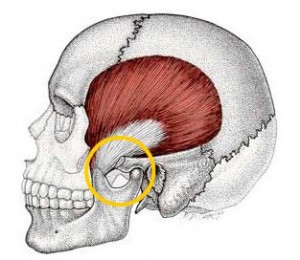TMJ Disorder
 There are three categories of TMJ disorders. A person may have one or more type of TMD condition simultaneously.
There are three categories of TMJ disorders. A person may have one or more type of TMD condition simultaneously.
TMJ conditions include:
- Myofacial Pain. This is the most common TMD condition that involves discomfort and pain in the muscles that control jaw movement.
- Internal Derangement. This TMJ disorder is associated with a displaced disc in the jaw joint, a dislocated jaw or an injury to the condyle, which is the part of the lower jaw that acts like a hinge.
- Arthritis. This TMD pain involves degenerative and inflammatory joint conditions.
Chewing Muscles
- Temporalis: This fan-shaped muscle is located on the side of the skull. It lifts and lowers the jaw, as well as pulls the lower jaw backward. Over-activation of this muscle is responsible for headaches in many people.
- Masseter: This is the main muscle for chewing that closes the mouth, and it exerts tremendous force when biting down.
- Internal (medial) pterygoid: This muscle lifts the lower jaw to close the mouth.
- External (lateral) pterygoid: This is the muscle that lets you open your mouth and move your lower jaw forward, as well as from side to side.
The AGD estimates that more than 10 million Americans suffer from TMD. Additionally, the TMJ Association predicts that as much as 65 to 85 percent of the U.S. population will experience some type of TMD symptom in their lifetime. TMD affects twice as many women as men, and is most prevalent among people between the ages of 20 and 40.
The temporomandibular joint slides and rotates in front of the ear on either side of the head. It consists of the temporal bone on each side of the skull and the lower jaw, which is also known as the mandible.
Four different chewing (mastication) muscles are paired on each side of the head and connect the lower jaw to skull. These muscles enable you to chew, open and close your mouth, and move your jaw forward, backward and side to side.
Because this area of the head and face contributes to chewing, jaw movement and bite (occlusion), TMJ disorders may cause pain at rest or during common movements such as talking, chewing and yawning.
Impact of TMD on Your Bite & Smile Esthetics
Certain causes of TMD also may affect your bite and subsequently impact the longevity of any smile makeover restorations you may want your dentist to provide. If your dentist identifies problems such as wear, tooth mobility, muscle pain or other signs of malocclusion, your bite may need to be adjusted.
Ensuring a stable bite is essential to your oral health and the long-term durability and functionality of cosmetic restorations such as dental veneers, Lumineers, tooth implants or crowns. Additionally, maintaining a stable occlusion and a proper bite helps ensure that your upper and lower teeth will come into contact in the most comfortable and pain-free manner possible, without unnecessary force that could lead to headaches or fractured restorations.
Find out more by requesting an appointment or contact us today.






